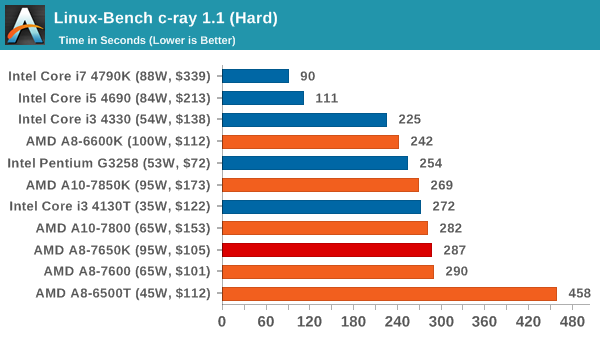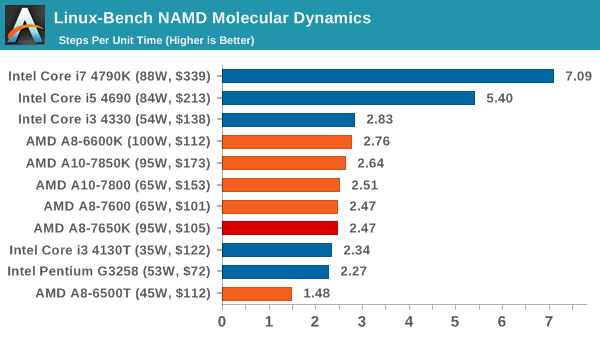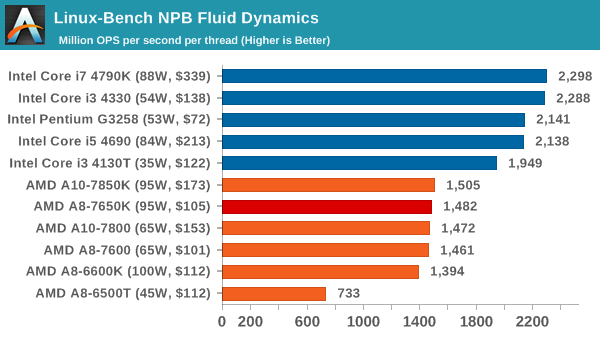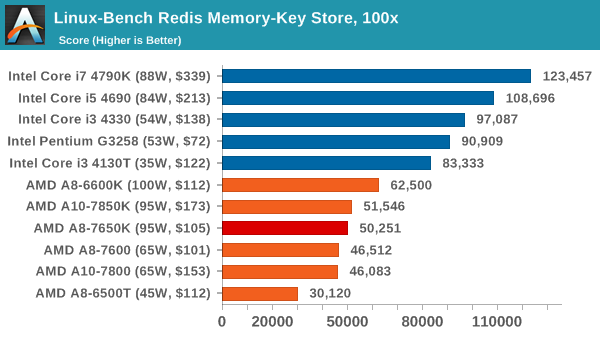The AMD A8-7650K APU Review, Also New Testing Methodology
by Ian Cutress on May 12, 2015 10:00 AM ESTProfessional Performance: Linux
Built around several freely available benchmarks for Linux, Linux-Bench is a project spearheaded by Patrick at ServeTheHome to streamline about a dozen of these tests in a single neat package run via a set of three commands using an Ubuntu 11.04 LiveCD. These tests include fluid dynamics used by NASA, ray-tracing, OpenSSL, molecular modeling, and a scalable data structure server for web deployments. We run Linux-Bench and have chosen to report a select few of the tests that rely on CPU and DRAM speed.
C-Ray: link
C-Ray is a simple ray-tracing program that focuses almost exclusively on processor performance rather than DRAM access. The test in Linux-Bench renders a heavy complex scene offering a large scalable scenario.

Being a scaling benchmark, C-Ray prefers threads and seems more designed for Intel.
NAMD, Scalable Molecular Dynamics: link
Developed by the Theoretical and Computational Biophysics Group at the University of Illinois at Urbana-Champaign, NAMD is a set of parallel molecular dynamics codes for extreme parallelization up to and beyond 200,000 cores. The reference paper detailing NAMD has over 4000 citations, and our testing runs a small simulation where the calculation steps per unit time is the output vector.

NAMD is similar to our office benchmarks, puttin the bulk of the APUs between the i3-4130T and the i3-4330.
NPB, Fluid Dynamics: link
Aside from LINPACK, there are many other ways to benchmark supercomputers in terms of how effective they are for various types of mathematical processes. The NAS Parallel Benchmarks (NPB) are a set of small programs originally designed for NASA to test their supercomputers in terms of fluid dynamics simulations, useful for airflow reactions and design.

Despite the rated memory on the APUs being faster, NPB seems to require more IPC than DRAM speed.
Redis: link
Many of the online applications rely on key-value caches and data structure servers to operate. Redis is an open-source, scalable web technology with a b developer base, but also relies heavily on memory bandwidth as well as CPU performance.











177 Comments
View All Comments
TrackSmart - Wednesday, May 13, 2015 - link
This comment is for Ian Cutress,First, thank you for the review, which was rich with performance figures and information. That said, something seems missing in the Conclusion. To be precise, the article doesn't really have a clear conclusion or recommendation, which is what many of us come here for.
It's nice to hear about your cousin-in-law's good experiences, but the conclusion doesn't clearly answer the key question I think many readers might have: Where does this product fit in the world of options to consider when buying a new processor? Is it a good value in its price range? Should it be ignored unless you plan to use the integrated graphics for gaming? Or does it offer enough bang-for-the-buck to be a viable alternative to Intel's options for general non-gaming usage, especially if motherboard costs are considered? Should we consider AMD again, if we are in a particular niche of price and desired features?
Basically, after all of your time with this chip and with your broader knowledge of the market offerings, what is your expert interpretation of the merits or demerits of considering this processor or its closely related AMD peers?
Nfarce - Thursday, May 14, 2015 - link
" Ultimately AMD likes to promote that for a similarly priced Intel+NVIDIA solution, a user can enable dual graphics with an APU+R7 discrete card for better performance."I have *long* wondered why Intel and Nvidia don't get together and figure out a way to pair up the on-board graphics power of their CPUs with a discrete Nvidia GPU. It just seems to me such a waste for those of us who build our rigs for discrete video cards and just disable the on-board graphics of the CPU. Game developers could code their games based on this as well for better performance. Right now game developer Slightly Mad Studios claims their Project Cars racing simulation draws PhysX from the CPU and not a dedicated GPU. However, I have yet to find that definitively true based on benchmarks...I see no difference in performance between moving PhysX resources to my GPUs (970 SLI) or CPU (4690K 4.7GHz) in the Nvidia control panel in that game.
V900 - Thursday, May 14, 2015 - link
Something similar to what you're describing is coming in DX12...But the main reason they haven't is because unless youre one of the few people who got an AMD APU because your total CPU+GPU budget is around 100$ it doesn't make any sense.
First if all, the performance you get from an Intel igpu in a desktop system will be minimal, compared to even a 2-300$ Nvidia card. And secondly, if you crank up the igpu on an Intel CPU, it may take away some of the CPUs performance/overhead.
If we're talking about a laptop, taking watts away from the CPU, and overall negatively impacting battery life will be even bigger drawbacks.
Nfarce - Thursday, May 14, 2015 - link
"But the main reason they haven't is because unless youre one of the few people who got an AMD APU because your total CPU+GPU budget is around 100$ it doesn't make any sense."Did you even read the hardware I have? Further, reading benchmarks from the built in 4600 graphics of i3/i5/i7 CPUs shows me that it is a wasted resource. And regarding impact on CPU performance, considering that higher resolutions (1440p and 4K) and higher quality/AA settings are more dependent on GPU performance than CPU performance, the theory that utilizing onboard CPU graphics with a dedicated GPU would decrease overall performance is debatable. I see little gains in my highly overclocked 4690K running at 4.7GHz and running at the stock 3.9GHz turbo frequency in most games.
All we have to go on currently is 1) Intel HD 4600 performance alone in games, and 2) CPU performance demands at higher resolutions on games with dedicated cards.
UtilityMax - Friday, May 15, 2015 - link
I am guessing that they didn't get together because dual-graphics is very difficult to make to work right. AMD is putting effectively the same type of GPU cores on the discrete GNUs and integrated APUs, and it still took them a while to make it work at all.V900 - Thursday, May 14, 2015 - link
I guess one thing we all learned today, besides the fact that AMDs APUs still kinda blow, is that there is a handful of people, who are devoted enough to their favorite processor manufacturer to seriously believe that:A: Intel is some kind of evil and corrupt empire ala Star Wars.
B: They're powerful enough to bribe/otherwise silence "da twooth" among all of Anandtech and most of the industry.
C: 95% of the tech press is corrupt enough to gladly do their bidding.
D: Mantle was an API hardcoded by Jesus Christ himself in assembler language. It's so powerful that if it got widespread, no one would need to buy a new CPU or GPU the rest of this decade. Which is why "they" forced
V900 - Thursday, May 14, 2015 - link
Which is why "they" forced AMD to cancel Mantle. Then Microsoft totally 110% copied it and renamed it "DX12".Obviously all of the above is 100% logical, makes total sense and is much more likely than AMD releasing shoddy CPUs the last decade, and the press acknowledging that.
wingless - Thursday, May 14, 2015 - link
AMD DOMINATION!!!!! If only the charts looked like that with discrete graphics as well....Vayra - Friday, May 15, 2015 - link
Still really can't see a scenario where the APU would be the best choice. Well, there may be one: for those with a very tight budget and wish for playing games on PC regardless. But this would mean that AMD has designed and reiterated a product that would only find its market in the least interesting group of consumers: those that want everything for nothing... Not really where you want to be.UtilityMax - Friday, May 15, 2015 - link
Well, right now arguably, if one has $500 bucks or less for a gaming PC build, it would be better to buy a Playstation 4. High end builds is where the money is in the enthusiast gaming market.